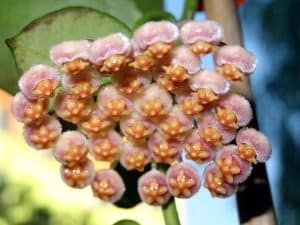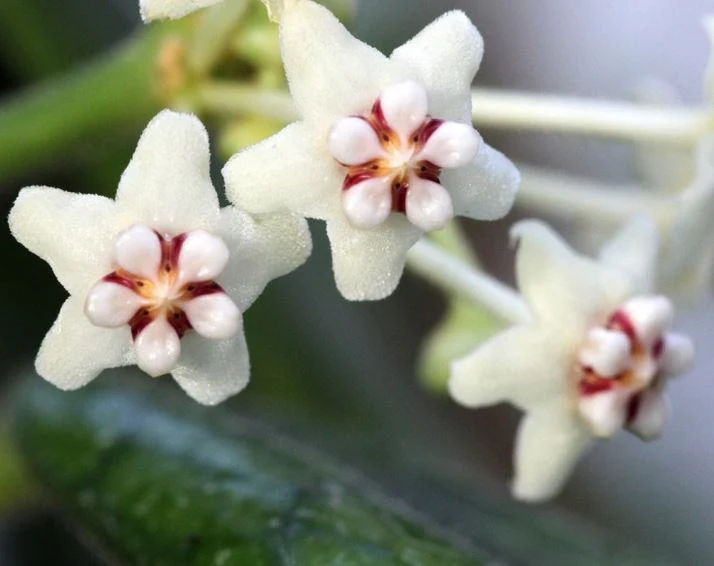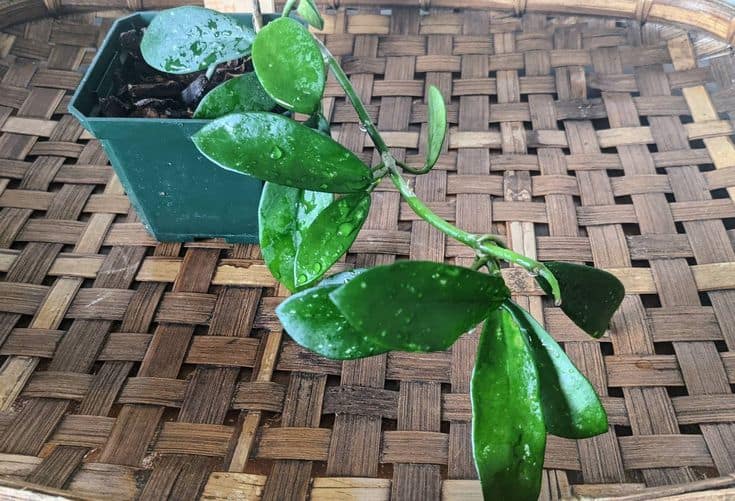Hoya Sunrise, a member of the Hoya carnosa family, can become easily confused with another Hoya that has the same common name, but belongs to a different plant family and has completely different care requirements.
Every hoya plant needs some sunshine to stay healthy and vibrant. Hoya sunrise has particularly bright flowers, so they need extra care to avoid burning them. If you’re growing hoya sunrises, follow these tips to keep your Hoya sunrise happy and healthy indoors all year long.
Have you recently acquired a Hoya Sunrise and are wondering what the best way to care for it is? Well, the following tips will help you keep your prized new plant healthy and thriving for years to come!
Hoya Sunrise plants are stunning tropical flowers that need plenty of sunlight and humidity to thrive, so here below is how to get care for them properly!
Origin and descriptions
Native to tropical Asia, these unique plants can be potted indoors in U.S. Department of Agriculture plant hardiness zones 10 through 12. Hoya plants are members of an exotic tropical plant family. But don’t let their strange, alien-like appearance fool you; Hoya sunrise is very easy to care for, needing only minimal sunlight and water to thrive.
When treated well and kept out of drafty areas, a Hoya can thrive for years. The easiest way to grow them is as houseplants—indoors with plenty of light but no direct sun exposure.
These plants are easy to grow from cuttings as long as they receive bright light, warmth, and lots of water. They do best in hanging baskets so that water is able to drain easily out of their natural containers. The containers can be glass or clay pots, either works fine.
Hoya sunrise propagation

Try propagating new plants by stem cuttings, to expand your collection and share with others. Cut off a healthy stem of your plant that’s around 4 inches long, and leave it in water.
Place it in an area with bright, indirect sunlight or under a fluorescent light indoors, making sure to keep it warm (between 65°F and 75°F). Keep changing out water as it becomes dirty, twice per week is ideal, and wait for roots to form within 6 weeks.
Once you see roots, you can transplant them into the soil. Be careful not to overwater when repotting! Overwatering will cause root rot.
General care information

To thrive, Hoya sunrise needs bright indirect light. A north-facing window is ideal (south is OK if it’s extremely bright). If you don’t have a bright window you can use artificial lighting to simulate sunlight.
When it comes to watering your hoya, make sure your soil is moist but not soggy. Water so that water comes out of drainage holes and drains from the bottom of the container when on its side.
Light requirements
Hoya sunrise are native to Africa and has evolved with short days and long nights. Indirect, morning sunlight is ideal for Hoya sunrise. A south-facing window is ideal if you don’t have a greenhouse, or at least place your plants in a location that gets bright light but not direct sunlight.
You can use artificial lighting such as fluorescent lights during winter months when natural light isn’t sufficient. If using artificial lighting, keep it on 12 hours per day.
Soil/potting mix
Hoya Plants are not picky when it comes to soil composition. Most tropical plants can thrive in good quality, all-purpose potting mix. The best way to determine if your plant’s soil is healthy is by doing a smell test—examine your soil; if it smells like dirt (like you might expect), you’re probably using a good potting mix.
If it has an unpleasant odor or doesn’t have any scent at all, chances are there isn’t enough organic material in your mix and it may be time for a change. You should also avoid overly wet soils as they tend to promote root rot and other fungal diseases that could kill your plant over time.
Watering
These plants like lots of water. During most months, you should water your plant once a week in sufficient amounts to saturate your soil.
Because Hoya sunrise are sensitive to chemicals, use rainwater or distilled water for watering. Tap water with chlorine and other chemicals can harm or even kill your Hoya sunrise.
Remember also that Hoya sunrise needs good drainage so that they don’t sit in wet soil all day long; they prefer sandy soil that drains quickly but retains enough moisture to keep them happy and healthy.
You may want to consider using drip irrigation instead of a sprinkler system when it comes time to water your plants, as drippers put out less water than sprinklers do.
You might also want to consider setting up an automatic timer on your hose so that it waters at certain times during each day—you can set it up so that it waters only during daylight hours if you wish.
Fertilizer
While Hoya sunrise is generally an adaptable plant that does not require much fertilizer, it is important to give them a little extra during their blooming season. It is important not to over-fertilize your plant or you risk burning its roots.
A single monthly application of 10-10-10 houseplant fertilizer should be adequate for most Hoya sunrise.
If you’re growing more than one hoya in a pot, divide your fertilizer evenly between them. If you want to go above and beyond and give your plant an even bigger boost, consider adding a pinch of Epsom salt into each watering as well. This will help strengthen weak stems and leaves while encouraging new growth on branches.
Temperature
In spring and summer when night-time temperatures are above 60 degrees F., turn your plant on its side and prop it up so that it stands almost vertically, exposing more of its leaves (and therefore their surface area) to lower temperatures at night.
Hoya sunrise humidity
While hoyas certainly like plenty of sunlight, they also need high humidity to thrive. Indoors, you can keep your plants at a humid 45-55% by misting them regularly and keeping them on trays of damp pebbles.
The same principles apply outdoors; find your plant’s most comfortable spot, dig a little hole for it (so it stays put), water it well, and then fill in around its roots with mulch or soil—allowing for ample drainage is key.
For Hoya sunrise to do well, they need high humidity. But they can’t be kept in a humid environment all year round, as that makes them vulnerable to rot. Plants need to breathe too!
Pruning
Like most garden plants, Hoya sunrise can benefit from a little tender loving care. A monthly dose of pruning will encourage strong new growth and flowers while removing dead leaves and excessive growth. At least once a month, remove any old leaves that have turned yellow or brown.
Use sharp shears to trim back any branches that are growing towards nearby plants or house windows. Prune for shape or size as desired but try not to over-prune: Hoya sunrise can be slow growers so drastic changes in form should be avoided.
When to repot
Hoya sunrise requires repotting when their roots begin to wind around or through their pots. You should also re-pot your hoya when you start to see yellowing leaves and branches, which indicates that your plant needs more space for its roots. Wait until new growth begins in spring or early summer to repot a hoya.
Repot your hoya into a pot, one size larger than it currently is using, high-quality commercial potting soil mixed with equal parts sand.
Water well and place it where it will receive bright indirect light but not direct sunlight for two weeks after transplanting. After two weeks, move it back into brighter light and resume watering as usual.
Dormancy
The most important thing you can do for your Hoya sunrise is put them in a cool, dry location during dormancy. Ideally, you will have an unheated garage or basement, or at least someplace where temperatures do not go above 65-70 degrees F (18-21 degrees C) and stay between 45-55 degrees F (7-13 degrees C).
If your area is too warm to maintain these conditions year-round, try wintering them in a cool room but keep an eye on humidity levels.
Dormant plants can be kept in their pots, but if they are placed directly into the soil, they may rot over winter. In either case, make sure there is good drainage so that water does not pool around the roots.
Do not fertilize while dormant as it may encourage new growth which could then be damaged by cold weather when it emerges from dormancy.
Flowers & fragrance

Hoya flowers are fragile and should be handled gently. When cut, they exude a pungent fragrance—not a bad thing! In fact, Hoya sunrise’s strong scent is partly what makes them such enjoyable houseplants.
But if you prefer a less potent smell, you can easily remove it by wiping down your plant with rubbing alcohol. A quick wipe-down will also help to remove any dust or dirt that may have accumulated on your plant while it was in transit from the nursery to your home.
Growth rate
Hoya sunrise are incredibly slow-growing, so even with small differences in care, a plant’s health and growth rate can vary greatly. On average, a new Hoya will grow about an inch per year.
Give your Hoya plenty of time to adjust to their new home before expecting them to grow quickly. If you do decide you’d like your Hoya to grow faster (or you aren’t sure what kind of care it requires), there are some things you can do.
In order to ensure that your hoya plants continue to grow, it is important to keep them in a sunny area of your home, and not just any sunny spot will do. As sunlight passes through the glass and other transparent materials it filters out a large percentage of UVA and UVB rays which are essential for optimal plant growth.
In addition to providing light, you should also avoid placing your plants near heating or cooling vents as these can dry out foliage quickly.
Toxicity
One of the biggest issues with Hoya sunrise is toxicity. This isn’t just an issue with Hoya sunrise; all plants and flowers can be poisonous if you ingest them or come into contact with their toxic chemicals.
It is essential to keep your Hoya sunrise out of reach of pets, small children, and sensitive individuals that may be allergic to certain plant parts (e.g., pollen). The leaves, stems, flowers, and sap are all toxic and should never be ingested.
USDA Hardiness Zones
Hoya sunrise will perfectly grow in USDA hardiness zones 10 and 12. In zone 10, it can survive temperatures as low as -10 degrees Fahrenheit (-23 Celsius). In zone 11, it can withstand temperatures as low as 5 degrees Fahrenheit (-15 Celsius).
It’s important to note that hoya plants don’t like frost or extreme heat. If you live in a climate with very cold winters, make sure to keep your plant indoors during these months.
Pests and diseases
It’s important to keep your hoya plants free of pests and diseases. An infestation can stress your plant, damage leaves, and branches, or even cause it to die. Pests include aphids, mites, whitefly, scale insects, and mealybugs. These pests are small creatures that are hard to see.
For protection from them—and other larger intruders such as snails—keep your plant indoors in a place that is well-lit with natural light but free of drafts. Keep humidity levels high around your plant by misting its leaves regularly. You should also water your plant when they need it rather than on a set schedule.
Overwatering can lead to root rot, which will kill your hoya over time. To prevent mold growth, don’t let water sit at the bottom of any container for more than 24 hours; if you do, discard any excess water and allow it to dry out before watering again.
Conclusion
The hoya sunrise is an easy plant to take care of and can be grown indoors or outdoors. The hoya sunrise thrives in bright, indirect light but will do well in a wide variety of light conditions.
This makes it an ideal houseplant. The key is to avoid direct sunlight which will burn its leaves. Watering should be done only when your plant feels dry, no more than once a week depending on how much light your plant receives and if you live in a humid environment.






